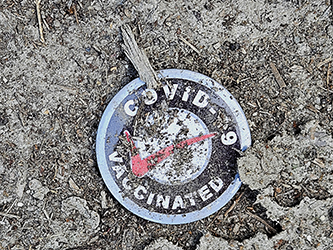In a year when a U.S. election, foreign wars, local corruption and global climate crises seem like life-and-death matters, there’s another issue.
Life and death. COVID and health.
Of course, if we’re bored reading about MoPox, EEE or other ailments, maybe we’ve lost a sense of urgency about COVID, which has become endemic — still with us, in some form. COVID changed the world, making Zoom meetings and social distancing familiar, and working from home routine for some jobs.
Somewhere between surrender and pandemic fatigue, we can feel lazy, “sick and tired,” or resentful of instructions we give our own kids: “wash your hands,” “wipe your nose,” “cover your mouth.”
But there can be dire health consequences if we stop obeying our own rules and think the risks are acceptable.
True, some who contract it have few symptoms; it’s an inconvenience. Some have a cough and/or a fever that sidelines them for a week or more. Others, mostly the chronically ill or seniors, are so severely affected they’re hospitalized and can die.
The number of COVID hospitalizations and fatalities has dropped a lot since 2020, and fewer test kits are sought, isolating after infection is sporadic, and masks have almost vanished. However, COVID cases have been surging, too — the virus is found in wastewater throughout the country, according to the Centers for Disease Control and Prevention. And this summer, the rate of COVID hospitalizations was double that of last summer, and COVID deaths occurred twice as often as in the spring. Then, a Gallup poll showed that 59% of U.S. adults say the pandemic is “over.”
But it’s changing, repeatedly. The COVID virus evolves frequently, so some assume vaccinations will be obsolete by winter anyway. But that doesn’t mean we let protection fade.
“New strains have emerged already — in August, KP.3.1.1 became the dominant strain, accounting for 36.8% of cases, according to the CDC’s Nowcast, which provides model-based early estimates,” said Katy Endress, Director of Epidemiology & Clinical Services at the Peoria City/County Health Department. “It has surpassed KP.3 (which overtook KP.2 earlier this summer). However, the new shots will continue to help protect against severe illness even if the virus mutates and additional strains appear.
“COVID-19 vaccines are updated to give you the best protection from the currently circulating strains,” she continued. “Pfizer’s and Moderna’s updated mRNA vaccines were approved in August for everyone ages 12 and older, and each has a Food and Drug Administration (FDA) emergency use authorization (EUA) for infants and children ages 6 months through 11 years. The mRNA vaccines target a SARS-CoV-2 strain called KP.2.”
Endress says the vaccinations are safe. Before vaccines are made available to everyday people, the FDA assesses findings from clinical trials to ensure they meet the FDA’s safety and effectiveness standards, and the agency keeps working to keep up.
“The FDA also authorized an updated COVID vaccine from Novavax for everyone 12 and older,” Endress said. “That shot targets another strain — JN.1. JN.1 was the dominant strain in May but was surpassed in June by a collection of other Omicron virus strains, including KP.2.”
Unlike other vaccinations the public has long accepted — including MMR (measles, mumps, rubella), DTP (diphtheria, tetanus, pertussis) and PCV (pneumonia) — COVID vaccinations aren’t yet required for school, and parents getting the shot for their children is fading, Chicago pediatrician Scott Goldstein told KFF Health News.
“The most important thing we do, you could argue, is vaccinating kids,” he said.
Yet only about 15% of eligible kids in the United States got the shot last year.
It’s also still vital for high-risk individuals to get the vaccination. Take the shot now.
“Everyone ages 6 months and older should get the 2024-25 COVID-19 vaccine as soon as possible,” says Endress, who adds that the vaccination can be part of preparing for winter.
“There is no recommended waiting period between getting a COVID-19 vaccine and other vaccines,” she says. “You can get a COVID-19 vaccine and other vaccines, including a flu and/or RSV vaccine, at the same visit.”



Recent Comments